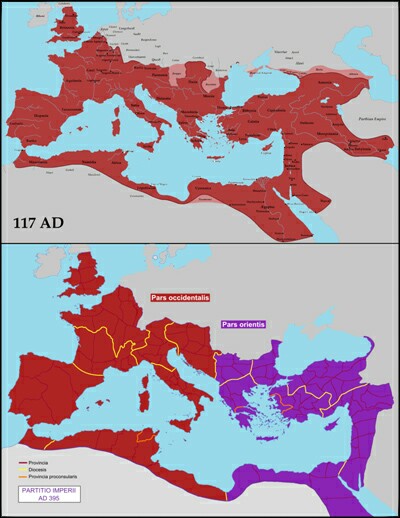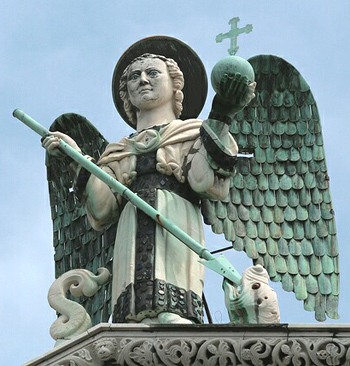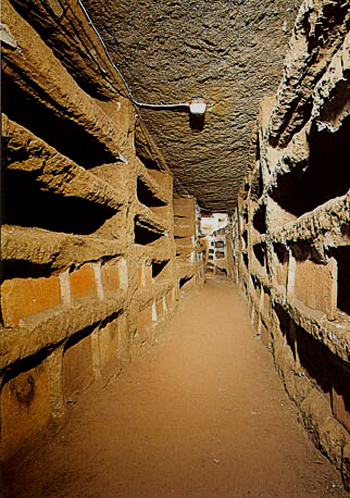Theology of History
 |
 |
 |
 |
 |
 |
 |
The Roman Empire & the Church - I
The First Christendom
Motivated by the general interest shown about the origins of the Middle Ages, we take this opportunity to pose some questions.
We know that the normal condition for the life and influence of the Church is to be supported by a civilization she generates, a temporal order formed and dominated by the Catholic spirit that serves as an instrument to facilitate her great task of the sanctification and salvation of souls. Just as God desires to guide the Church in realizing His words throughout History, so also God desires to establish, develop and protect a Catholic Civilization.
Taking this into consideration, we can ask: Who are the providential persons that can make a civilization? What are the situations, problems, crises and difficulties that a Catholic Civilization has to face in order to exist?
From here, other questions necessarily rise: What were the difficulties in the first attempts to make a Catholic Civilization? What factors contributed to its realization? What factors presented obstacles to it?
This is what we will begin to study now by analyzing the position of the Church in the Roman Empire and, then, her relation with a great and somewhat enigmatic personage, the Emperor Justinian.
 The Roman Empire is represented as one entity on this map - at right top - at the time of Trajan in the 2nd century after Christ. Later, in the 4th century the Empire was divided by Emperor Diocletian into two parts, the West and East. He also divided the power, keeping the Eastern part for himself and appointing Maximian as Emperor of the West.
The Roman Empire is represented as one entity on this map - at right top - at the time of Trajan in the 2nd century after Christ. Later, in the 4th century the Empire was divided by Emperor Diocletian into two parts, the West and East. He also divided the power, keeping the Eastern part for himself and appointing Maximian as Emperor of the West.
Thus, there were two Augustus, and each had under his direction a Caesar, the appointed heirs of the Emperors. Those four men formed a Tetrarchy, which theoretically exercised full power over the whole Empire. So, a difference was established between the Western Roman Empire and the Eastern Roman Empire.
The second map shows the whole Roman Empire shortly after the time the Church left the Catacombs in the 4th century, which very generically represents Christendom at that time. We see the exceptional geographic situation of the Empire situated around the Mediterranean, which the Romans called Mare Nostrum [Our Sea]. The Empire also encompassed the fertile territories of North Africa, the very civilized and rich areas of Asia Minor, the cultural and somewhat wealthy regions of Greece and Italy, and, above all, the European wilderness made of Spain, France, part of Germany and the faraway Britain, where civilization still had not been implanted.
After the West became Catholic, and Constantine declared the Catholic Faith the religion of the Empire in the East, this Empire represented Christendom. Until the Edict of Milan was signed in 313, the Church lived in the Catacombs. When she emerged, unfortunately she was contaminated by heresies. As soon as she left the Catacombs, she began to be attacked by Nestorianism, Arianism and other heresies that came later. Therefore, this Christendom appears to us, from many aspects, to be a rotten Christendom.
 St. Teresa of Ávila had a famous vision in which she saw a very lax convent in the Spain of her time, and on top of it an Angel was sitting. She asked the Angel the meaning of that vision. He explained to her that even though it was a lax convent, there were still some virtuous souls who held to some values. Such is God’s commitment to protect the just that He sent that Angel to watch over the convent.
St. Teresa of Ávila had a famous vision in which she saw a very lax convent in the Spain of her time, and on top of it an Angel was sitting. She asked the Angel the meaning of that vision. He explained to her that even though it was a lax convent, there were still some virtuous souls who held to some values. Such is God’s commitment to protect the just that He sent that Angel to watch over the convent.
Now then, if this can be said about a convent, it can be said with greater reason about a civilization such as the one we are studying here along the banks of the Mediterranean. We can say that the Guardian Angel of the Roman Empire hovered over it, accompanied by the Angels who protected the just souls who lived there.
When we speak of the rottenness of the Roman Empire, we must make several reservations about that general state. First, although we know that the emerging heresies undermined Catholicism in the Empire, we also know that their representatives extirpated almost all the remains of Paganism, destroying its temples and monuments in a movement quite different from that of the Renaissance, which promoted the re-emergence of pagan art and architecture.
Second, we know that when the hordes of barbarians began their onslaught against the Empire, the behavior of the ecclesiastic dignitaries was the opposite of that of the civil dignitaries. While the civil leaders shamefully fled, the ecclesiastic authorities stalwartly remained - the Bishops in their dioceses and the priests in their parishes. Thus, as the Western Empire fell apart, the Church stood solidly throughout the cataclysm. Even though the Church of that time lacked the vitality to make a crusade against the barbarians, nonetheless she had enough energy to continue to exist despite the invasions and the heresies.
 Third, another point to stress is that when Clovis, the first King of the Franks who united all of the Frankish tribes under his command, converted and was baptized in 496, he started his action to protect Catholics. Then, the influence of the Catholic Church was broad enough to give Clovis an international prestige and present him as a model king and leader. The projection of this model played an important role in the conversion of other barbarians and the establishment of Medieval Christendom.
Third, another point to stress is that when Clovis, the first King of the Franks who united all of the Frankish tribes under his command, converted and was baptized in 496, he started his action to protect Catholics. Then, the influence of the Catholic Church was broad enough to give Clovis an international prestige and present him as a model king and leader. The projection of this model played an important role in the conversion of other barbarians and the establishment of Medieval Christendom.
Therefore, the Catholics of those times, even though they were very lax, were able to accomplish these good things. Thus we see that, despite being a rotten Christendom deserving of censure for the decadence that it had and caused, it was a Christendom that was still much better than the situation of Catholics we are witnessing in many of today's countries.
We can see that that Christendom deserved the chastisement of the invasion of the barbarians - remember that Attila called himself ‘the scourge of God’ because he believed God had chosen him to punish the Roman peoples of that time. If that Christendom deserved a chastisement, we can say that the situation of mankind today is more than ripe for another chastisement.
Continued

We know that the normal condition for the life and influence of the Church is to be supported by a civilization she generates, a temporal order formed and dominated by the Catholic spirit that serves as an instrument to facilitate her great task of the sanctification and salvation of souls. Just as God desires to guide the Church in realizing His words throughout History, so also God desires to establish, develop and protect a Catholic Civilization.
Taking this into consideration, we can ask: Who are the providential persons that can make a civilization? What are the situations, problems, crises and difficulties that a Catholic Civilization has to face in order to exist?
From here, other questions necessarily rise: What were the difficulties in the first attempts to make a Catholic Civilization? What factors contributed to its realization? What factors presented obstacles to it?
This is what we will begin to study now by analyzing the position of the Church in the Roman Empire and, then, her relation with a great and somewhat enigmatic personage, the Emperor Justinian.

The Roman Empire at its apogee under Trajan, above, and at the end of the 4th century, after being divided
Thus, there were two Augustus, and each had under his direction a Caesar, the appointed heirs of the Emperors. Those four men formed a Tetrarchy, which theoretically exercised full power over the whole Empire. So, a difference was established between the Western Roman Empire and the Eastern Roman Empire.
The second map shows the whole Roman Empire shortly after the time the Church left the Catacombs in the 4th century, which very generically represents Christendom at that time. We see the exceptional geographic situation of the Empire situated around the Mediterranean, which the Romans called Mare Nostrum [Our Sea]. The Empire also encompassed the fertile territories of North Africa, the very civilized and rich areas of Asia Minor, the cultural and somewhat wealthy regions of Greece and Italy, and, above all, the European wilderness made of Spain, France, part of Germany and the faraway Britain, where civilization still had not been implanted.
After the West became Catholic, and Constantine declared the Catholic Faith the religion of the Empire in the East, this Empire represented Christendom. Until the Edict of Milan was signed in 313, the Church lived in the Catacombs. When she emerged, unfortunately she was contaminated by heresies. As soon as she left the Catacombs, she began to be attacked by Nestorianism, Arianism and other heresies that came later. Therefore, this Christendom appears to us, from many aspects, to be a rotten Christendom.

An Angel watched over the nascent Christendom
Now then, if this can be said about a convent, it can be said with greater reason about a civilization such as the one we are studying here along the banks of the Mediterranean. We can say that the Guardian Angel of the Roman Empire hovered over it, accompanied by the Angels who protected the just souls who lived there.
When we speak of the rottenness of the Roman Empire, we must make several reservations about that general state. First, although we know that the emerging heresies undermined Catholicism in the Empire, we also know that their representatives extirpated almost all the remains of Paganism, destroying its temples and monuments in a movement quite different from that of the Renaissance, which promoted the re-emergence of pagan art and architecture.
Second, we know that when the hordes of barbarians began their onslaught against the Empire, the behavior of the ecclesiastic dignitaries was the opposite of that of the civil dignitaries. While the civil leaders shamefully fled, the ecclesiastic authorities stalwartly remained - the Bishops in their dioceses and the priests in their parishes. Thus, as the Western Empire fell apart, the Church stood solidly throughout the cataclysm. Even though the Church of that time lacked the vitality to make a crusade against the barbarians, nonetheless she had enough energy to continue to exist despite the invasions and the heresies.

The Catacomb of St. Priscilla, Rome
Therefore, the Catholics of those times, even though they were very lax, were able to accomplish these good things. Thus we see that, despite being a rotten Christendom deserving of censure for the decadence that it had and caused, it was a Christendom that was still much better than the situation of Catholics we are witnessing in many of today's countries.
We can see that that Christendom deserved the chastisement of the invasion of the barbarians - remember that Attila called himself ‘the scourge of God’ because he believed God had chosen him to punish the Roman peoples of that time. If that Christendom deserved a chastisement, we can say that the situation of mankind today is more than ripe for another chastisement.
Continued

Posted February 11, 2013
______________________
______________________











